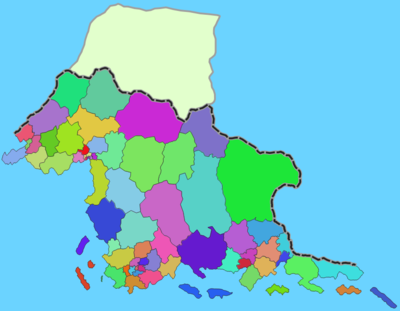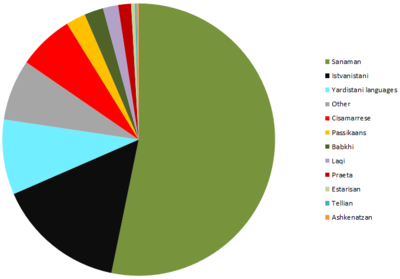Sanama (Third Republic): Difference between revisions
No edit summary |
No edit summary |
||
| Line 125: | Line 125: | ||
[[Category:Sanama]] | [[Category:Sanama]] | ||
[[Category:Shirerithian Vulture States]] | |||
Revision as of 23:24, 24 June 2019
| Democratic Federation of Sanama (ist) Feterazone Temokeratika Sanamaya (san) | |||
| |||
| Motto: From Each According to Ability, to Each According to Need | |||
| Anthem: | |||
| [[|250px|Location of Sanama|frameless]] | |||
| Map versions | n/a | ||
| Capital | Niyi (Nee) | ||
| Largest city | Fatehpur Sikri, Thanatos | ||
| Official language(s) | Sani, Ama, Cisamarrese, Istvanistani | ||
| Official religion(s) | Atheism, traditional religions, Cedrism | ||
| Demonym | Sanaman | ||
| - Adjective | Sanaman | ||
| Government | Communalist federation with representative and direct democracy | ||
| - Federal Council | Federal Council serves as collective head of state | ||
| - Legislature | Federal Assembly | ||
| Establishment | 7.VII.1671 | ||
| Population | 53,500,000 | ||
| Currency | Natopian natopo (₦) | ||
| Abbreviation | FSA | ||
| Time zone(s) | CMT-9 | ||
Officially Democratic Federation of Sanama, Sanama is the name given to the areas controlled and administered by the Sanilla and Amarra Liberation Army for Democracy. Its stated goal is to establish a federation of locally administered districts in the former Shirerithian county of Amarr, southwestern Lachmodan and southern Highpass. These areas are home to the Sanis and Amas, two closely related ethnicities. There are also numerous Sanis in Talenore, where Sani is an official language.
History
The Sanilla and Amarra Liberation Army for Democracy declared independence on behalf of Sanama in 1671 as a consequence of the Kalirion Fracture. The Kalirion Fracture sent the local government into disarray. Years upon years of debauchery and excesses in the nobility had lead to a government in all but name. Fueled by the outrage of the working masses at the discrimination leveled against them by the bourgeoisie landowners and nobility, the SALAD quickly took control of the former county of Amarr. They also pushed forward towards Twoggle, since that area of the Lachmodan coast is majority Sani. The islands of Ž and Azarea also joined after local uprisings.
On 12.X.1671 the SALAD leaders announced that Sanama had been liberated from fascists and imperialists. They announced elections for local citizens' assemblies to take place on 15-16.X.1672. The SALAD leadership also committed to not fielding any candidates nor participate as a party in the election. It also launched a campaign to get people to vote, with efforts to educate the people.
Sanama disputes southern Highpass with the local bourgeoisie and a low intensive war has broken out along a line of control.
In 1672 the provisional government adopted the Natopian natopo as the currency of Sanama. The Shirerithian Erb had been used up until then, but since the Kalirion Fracture, that currency is in free fall. To stabilize prices and secure the important revenue from oil exports, the government unilaterally adopted the Natopo.
On 2.V.1673, the people of Sanama voted to change the official name of the country from the Democratic Federation of Sanilla and Amarra to the Democratic Federation of Sanama.
Government
The aspiration is to establish a democratic federation in Sanama, based on local self government. Until that can be achieved, the SALAD governs the areas under its control. It operates under a system with dual leadership, one man and one woman, and where possible, one Sani and one Ama. The executive, legislative and judicial power is temporarily vested in the National Revolutionary Council. The council is chaired by Takir Koshë, a Sani man, and Delah Nihor, an Ama woman. The council is selected from the SALAD and the traditional clan leadership.
Administrative divisions
Sanama is divided into 68 cantons, not including the claimed area in Lower Highpass.
Foreign relations
| State | Relation | Established | Basis |
|---|---|---|---|
| Unified Governorates of Benacia | Friendly | 1672 | Informal trade agreement |
| Elwynn | Friendly | 1672 | Shared attitude towards Shireroth |
| Shireroth | Negative | 1672 | Former imperial power, conflict over Lower Highpass |
| Drak-Modan | Friendly | 1672 | Close neighbor, shared currency |
| Tellia | Friendly | 1672 | Trade relationship, friendly neighbors |
| Guttuli | Negative | 1672 | Critical towards expansionism |
| Sovereign Confederation | Neutral | 1672 | Distance between borders |
| Natopia | Friendly | 1672 | Shared currency |
| Jingdao | Hostile | 1672 | Raspur Pact solidarity |
| Alduria | Positive | 1673 | Trade relationship |
| Haifo-Palliscan Trade Union | Hostile | 1672 | Raspur Pact solidarity |
Culture
Language
Main article: Languages of Sanama
Sanama is a multicultural country with several indigenous languages. The majority language, spoken by nearly half of the population, is Sani. The closely related Ama is spoken by more than a quarter of the people, while Cisamarrese is spoken by around ten percent. The remaining part of the population speaks Istvanistani, Praeta and several immigrant languages. The Estarisan language is spoken on the island of Estarisa (Azarea) to the southeast. It was during the Shirerithian occupation considered to be a dialect of Sani, but is now being reclassified as a language in its own right due to not being mutually intelligible with either Sani or Ama.
Sani, Ama, Cisamarrese and Estarisan are designated as national official languages, while Istvanistani is designated as administrative language by the provisional government. Due to a lack of interest from the former colonial power, the actual number of speakers of the various languages is somewhat unclear and remains for the time being an approximation. The provisional government has recommended that a more thorough census be taken after the local elections in 1672.
Religion
Sanama is a religiously diverse country with no one religion dominating. Cedrism is popular among the Istvani and Praeta speaking people. It also has numerous followers from the Sani and Ama due to being promoted during imperial rule. A large number of Sani and Ama follow traditional polytheistic religion. A significant minority also profess no religion or atheism.
Culture
There is no national Sanaman culture, although the federal government is promoting values based on humanism, democracy, pluralism, egalitarianism and tolerance. Cultural and ethnic identity is closely related to language, but there are people identifying as one ethnicity while speaking another language, mostly Istvani. This is a remnant from Istvani being considered a prestige language during imperial rule.
Transportation
| ||||||||||||||||||||||



